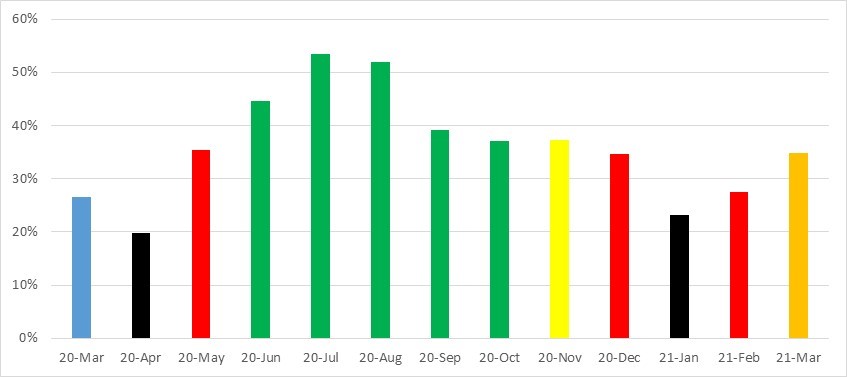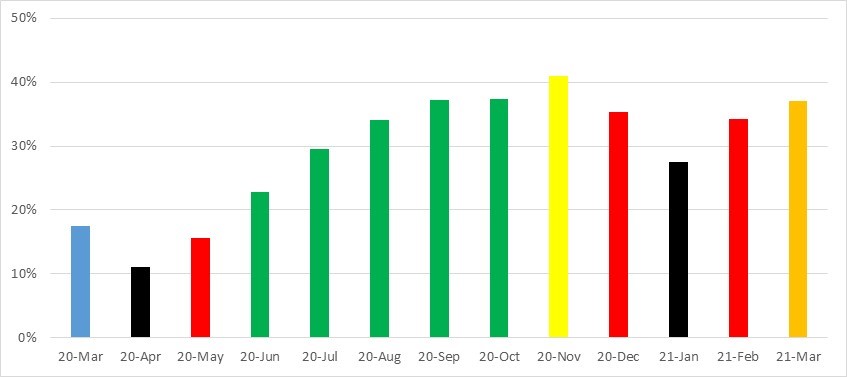Staff Report #4
March 31, 2021
To All Commissioners
Re: Recosted 2021 Operating Budget Program
Recommendations
The Commission:
- APPROVE the recosted 2021 operating expenditure budget for London’s public transit services of $90,601,700 as summarized on the following table;
| Description | Conventional Transit | Specialized Transit | Total | |
| Revenue | ||||
| Transportation revenue | $25,587,700 | $ 387,000 | $25,974,700 | |
| Operating revenue | 1,089,400 | – | 1,089,400 | |
| Transfer from reserves | 1,121,600 | – | 1,121,600 | |
| Provincial gas tax funding | 9,540,400 | 1,705,800 | 11,246,200 | |
| Total Revenue | 37,339,100 | 2,092,800 | 39,431,900 | |
| Expenditure | ||||
| Personnel cost | 55,071,300 | 1,190,700 | 56,262,000 | |
| Fuel | 6,811,000 | – | 6,811,000 | |
| Direct bus maintenance | 6,647,000 | – | 6,647,000 | |
| Facility | 3,244,200 | – | 3,244,200 | |
| Insurance | 3,830,600 | – | 3,830,600 | |
| Contribution to reserves | 945,100 | – | 945,100 | |
| Contracted service costs | – | 8,500,100 | 8,500,100 | |
| All other material costs | 4,103,300 | 258,400 | 4,361,700 | |
| Total Expenditures | 80,652,500 | 9,949,200 | 90,601,700 | |
| Safe Restart Program | 11,335,600 | (998,000) | 10,337,600 | |
| City of London | $31,977,800 | $8,854,400 | $40,832,200 | |
Background
The Commission approved the 2021 base operating budget programs for conventional and specialized transit services as set out in the table below in August 2020.
| Category | Conventional | Specialized | Total |
| Revenue | $ 39,848,800 | $ 2,338,700 | $ 42,187,500 |
| Expenditures | 80,986,100 | 11,019,400 | 92,005,500 |
| City of London | $ 29,820,100 | $ 8,680,700 | $ 38,500,800 |
| Budget Shortfall | $ 11,317,200 | $ 11,317,200 |
As indicated in the table, at the time the budget was approved, there was an identified shortfall of $11.3 million, which was anticipated to be the result of pandemic-related impacts on the operation. As part of the approval of the above budget, the Commission also directed administration to report back on options to mitigate the shortfall in March of 2021.
In addition to the approval of the base operating budget, the Commission also approved the growth budget of $1,236,400 to cover service growth for both the conventional and specialized services, noting this growth request would be forwarded to the City of London to be funded through assessment growth.
Municipal Council approved the base budget request in January 2021, and the assessment growth request in March 2021, all of which are reflected in the recosted 2021 operating budget set out in the report recommendation.
Consistent with established practices, the 2021 budget has been through a recosting exercise, noting this year the intent of the exercise was not only to identify significant trends and/or emergent issues that have developed since the budget was first prepared, but also to identify the manner in which the projected shortfall would be addressed. As set out in Staff Report #6, dated March 31, 2021, the Transfer Payment Agreement details for Phase II of the Safe Restart Funding, as well as the Phase III allocations have been confirmed. The recosted operating budget projects that $10.3 million of Safe Restart funding will be required to balance the 2021 budget.
Conventional Transit Service
In order to complete the 2021 budget, a number of key assumptions were applied, many of which have been refined given updated trending and the current and predicted pandemic situation through the remainder of the year. The following table sets out the updates that have been applied to the conventional transit service operating budget as the result of the recosting.
2021 Recosted Conventional Transit Service Operating Budget
| Description | 2021 Budget | Update | 2021 Recosted |
| Revenue | |||
| Transportation Revenue | $ 29,248,500 | $ (3,660,800) | $ 25,587,700 |
| Operating Revenue | 1,253,900 | (164,500) | 1,089,400 |
| Transfer from Reserves | 1,121,600 | – | 1,121,600 |
| Provincial Gas Tax | 8,353,900 | 1,186,500 | 9,540,400 |
| Total Revenue | 39,977,900 | (2,638,800) | 37,339,100 |
| Expenditure | |||
| Personnel | 55,567,000 | (495,700) | 55,071,300 |
| Fuel | 7,312,100 | (501,100) | 6,811,000 |
| Direct Bus Maintenance | 6,675,600 | (28,600) | 6,647,000 |
| Facility | 3,244,200 | – | 3,244,200 |
| Insurance | 3,830,600 | – | 3,830,600 |
| Contribution to Reserves | 1,445,100 | (500,000) | 945,100 |
| All Other Material Costs | 4,103,300 | – | 4,103,300 |
| Total Expenditures | 82,177,900 | (1,525,400) | 80,652,500 |
| Safe Restart Program | 11,335,600 | 11,335,600 | |
| City of London | 30,882,800 | 1,095,000 | 31,977,800 |
| Surplus / (Deficit) | $ (11,317,200) | $ 11,317,200 | $ – |
In 2020, the City of London allocated $1,095,000 of assessment growth funding to London Transit to assist with pandemic-related budget impacts. At the time of budget preparation in August 2020, it was unknown whether this allocation would become a permanent part of the City of London operating contribution. In early 2021, the civic administration confirmed this allocation was permanent, and as such, the City of London contribution has been amended in the 2021 recosted budget to reflect same.
The most significantly impacted area of the conventional transit service budget resulting from the pandemic is the revenue from ridership. The revenue shortfall in 2020 was significant given fares were not collected for five months, and ridership remained low for the entire year. The graph below illustrates the impacts of the pandemic declaration on the conventional service ridership. The bars are coloured to match the Provincial colour schemes associated with the various stages of lockdown, with black being a full, province-wide lockdown, and green being no/limited restrictions in place, noting March 2020 is coloured blue given the actual pandemic declaration and impacts locally occurred late in that month.
Conventional Transit Service Ridership as a Percent of Normal

As the graph illustrates, conventional transit ridership is heavily influenced by the level of restriction that is in place, but also, that ridership hovers at between 20% and 25% of normal during a full province-wide lockdown as essential workers continue to rely on transit to get to/from work. When assessing this graphic, it is important to recognize that, throughout the pandemic period, post-secondary student ridership was very limited given the relatively low cohort of students that were required to attend campus as the result of the move to online learning.
Given the ongoing existence of the tuition pass program throughout the pandemic period and through 2021, ridership projections were assessed in two separate categories. With respect to the tuition ridership and related revenue, the recosted budget assumes that the number of tuition passes purchased for the 2021/22 academic year, which will affect September through December of 2021, will remain consistent with those purchased for the 2020/21 academic year; however, the ridership is projected to increase beginning in September given the anticipated return to campus for most students.
In terms of the ridership and related revenue for all other riders (cash, ticket and monthly pass categories), projections were adjusted to be reflective of the current situation as well as what is anticipated based on the experience in 2020 as set out in the graph above. As a result of the reassessment, ridership projections have been reduced for 2021 to 11.4 million, down from the original projection of 18.0 million.
Provincial Gas Tax revenues were adjusted to cover budget impacts that are not pandemic related, primarily the increase in general insurance costs associated with the 2020 insurance renewal.
In terms of expenditures, personnel costs were adjusted to reflect the current operating conditions (90% of planned service levels) which is anticipated to continue through the summer and then return to 100% levels in September of 2021. While this adjustment resulted in a $1.5 million reduction, it was offset by a $0.7 million increase in employee benefit premiums, which saw a significant increase in 2021 due to the number of pandemic-related short term disability claims.
Fuel was adjusted to be reflective of the fewer kilometres travelled due to the service levels in place versus planned.
Contribution to reserves was reduced given the year-end adjustments that were made resulted in a much more favourable position for the Commission reserves, details of which are set out in Staff Report #3, dated March 31, 2021.
As indicated in the table, the Safe Restart Program is projected to be relied upon for $11.3 million in order to balance the 2021 conventional service operating budget. The details with respect to London’s allocation of Safe Restart funding as well as the guidelines for use are set out in Staff Report #6, dated March 31, 2021.
Specialized Transit Service
Similar to the recosting for conventional services, the same review was performed for specialized transit. The table below sets out the adjustments to the 2021 specialized operating budget and the resulting recosted budget.
Recosted 2021 Specialized Transit Service Operating Budget
| Description | 2021 Budget | Updates | 2021 Recosted |
| Revenue | |||
| Passenger fares | $ 647,100 | $ (260,100) | $ 387,000 |
| Provincial funding | 1,075,800 | – | 1,705,800 |
| Total Revenue | 2,352,900 | (260,100) | 2,092,800 |
| Expenditure | |||
| Personnel cost | 1,190,700 | 1,190,700 | |
| Contracted services | 9,758,200 | (1,258,100) | 8,500,100 |
| All other material costs | 258,400 | 258,400 | |
| Total Expenditures | 11,207,300 | (1,258,100) | 9,949,200 |
| Safe Restart Program | – | (998,000) | (998,000) |
| City of London | $8,854,400 | $ – | $ 8,854,400 |
Consistent with the conventional service operating budget, Municipal Council approved the assessment growth business case for the specialized service as well. This will result in an increase of approximately 6,000 annualized service hours in 2021.
The graph below illustrates the impacts of the pandemic declaration on the specialized service ridership. The bars are coloured to match the Provincial colour schemes associated with the various stages of lockdown, with black being a full, province-wide lockdown, and green being no/limited restrictions in place, noting March 2020 is coloured blue given the actual pandemic declaration and impacts locally occurred late in that month.
Specialized Transit Service Ridership as a Percent of Normal

As the graph indicates, the specialized service ridership fluctuated with the various levels of restrictions; however, never climbed above 41% of normal over the pandemic period. Of interest, ridership levels remained much higher during the second province-wide lockdown as compared to the first.
The ridership and related revenue projections for the recosted 2021 specialized operating budget have been amended to be more reflective of the trends experienced over the past six months, resulting in a reduction in transportation revenue. It should be noted that service levels will continue to be adjusted to match demand for the service, and are anticipated to be back to full service in the fall of 2021.
On the expenditure side, the contracted service costs have been reduced given the anticipated service levels that will remain in place until September.
As indicated in the table, the net reduction in the specialized service operating budget will be applied against the increased costs (relating to the pandemic) on the conventional service operating budget consistent with the Safe Restart Program guidelines.
Administration will continue to monitor the operating budget performance, reporting on same on a monthly basis throughout 2021.
Recommended by:
Mike Gregor, Director of Finance
Concurred in by:
Kelly S. Paleczny, General Manager